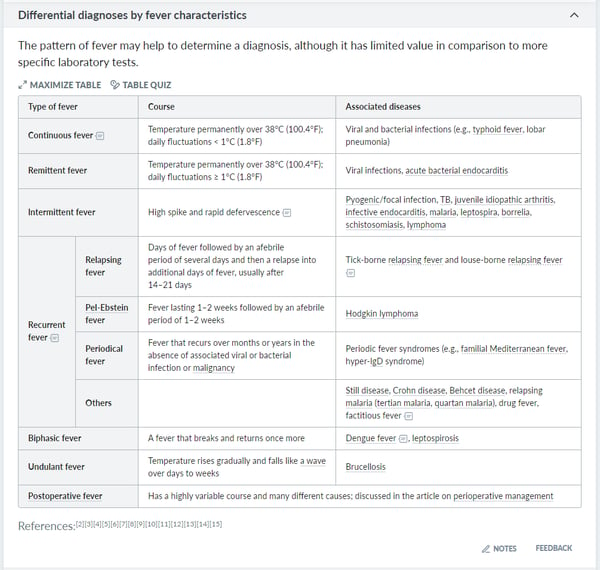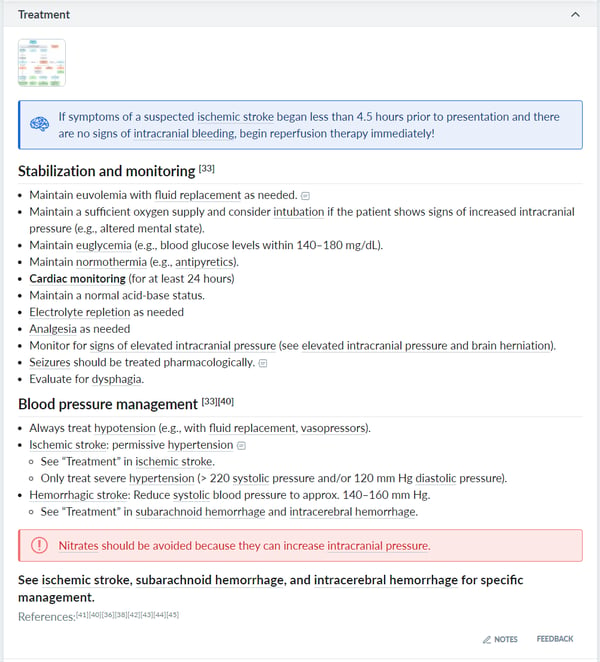How to Succeed in Your Clinical Clerkships With AMBOSS
.png)
Clinical clerkships are the time in medical school when everything starts to come together. The relevance of all the lectures you’ve sat through over the past two years begins to reveal itself, and you finally have the chance to put your desire to help patients into practice.
The transition into medical clerkships brings many changes in your roles and responsibilities. On the one hand, you’ll need to act as a confident and self-assured care provider who gives support and guidance to the patients in your care. On the other hand, members of your care team will expect you to be an eager apprentice who understands their place within the medical hierarchy.
Prepare for your clerkships with the AMBOSS Clerkship Survival Guide
Becoming an excellent doctor is a life-long journey, and at several points during clinical rotations, it may feel as though the ‘training wheels’ have been taken off just a little bit too soon.
Thankfully, this is where AMBOSS can help. AMBOSS is designed with clerkship students and clinical rotations in mind, making it the ultimate resource to get you over any hurdles.
Here are seven ways that AMBOSS can help you succeed during clerkships:
1. How to prepare for a clerkship
2. How to establish a diagnosis during clinical rotations
3. How to develop a treatment plan
4. How to draft a patient presentation
5. Studying a particular diagnosis
6. Quickly look up information during clinical clerkships
7. How to study for Shelf exams while in the hospital or clinic
How to prepare for a clerkship
We’ve all been there: You’re a few days away from your first clerkship, or hoping to make the most of the small bit of time you have between clinical rotations. You’ve heard some stories from your classmates about what lies ahead, but you’re not sure how things ‘really work’ or how you can best contribute.
To help you be prepared for each clerkship, we’ve created the AMBOSS Clerkship Survival Guide which you can find within the AMBOSS library. This guide is made up of a collection of digestible and peer-reviewed articles, each offering valuable clinical rotation tips over a wide range of topics. They’ll prepare you for the differing roles that, as a medical student, you’ll have from clerkship to clerkship. This is important not only in terms of the day-to-day schedule or responsibilities but also in team dynamics and workflows.
Another way you can sufficiently prepare for a clerkship is by exploring that clerkships’ branch of the AMBOSS library. In many cases, articles with fundamental clerkship content are positioned near the very top.
How to establish a diagnosis during clinical rotations
Picture this: While looking for ways to contribute, you routinely interview and examine patients unfamiliar to you and your team. You gather many insights about your patient, but you don’t quite have the quick intuition needed to synthesize them into actionable insights. Each conclusion you reach about a diagnosis brings more questions, and you’re not quite sure where to start.
Creating a differential diagnosis is a critical element of medicine that you will begin to perform independently during the clerkship year. The AMBOSS library contains many articles dedicated to specific findings or chief complaints that will help you with this process. Within these articles, you’ll find information related to the various causes of the issue at hand, with differentiating information about each cause.

For a collection of these articles particularly relevant to the in-patient setting, be sure to check out the AMBOSS On-Call Survival Guide.
To confirm a particular diagnosis, search for the relevant AMBOSS article and visit the “Clinical features” and “Diagnostics” sections. Both sections are packed with insights that will give you a real sense of that diagnosis’ fit.
How to develop a treatment plan
You’ve now got a firm understanding of just what is happening to your patient, but larger questions remain: where do we go from here? The permutations and combinations of therapeutic options are numerous, but you begin to search for clarity. In an ideal world, you’d have an accessible resource that can act as your jumping off point for all therapeutic decisions.
As a medical student on the wards, knowing which therapies are worthy of your attention can be difficult. Medical standards are always changing, and the therapeutic options available to you often depend on the health system in which you’ll be working.
AMBOSS articles help you formulate a treatment plan by providing you with a list of therapies worthy of your consideration. There, you will find insights about indications, contraindications, timeline, dosing, and other characteristics packaged into easy-to-read bulleted lists and tables.
Management flowcharts can also help you streamline your management approach.
How to draft a patient presentation
You have some understanding of what direction you'd like to drive your patient's care, but you're not quite sure how to package these insights into a patient presentation. You're looking for a collection of relevant insights that can help you draft well-structured presentations that provide context and address hypotheticals, preparing you for any discussions that are sure to take place.
To get an overall sense of how to approach this, visit patient presentations in the Clerkship Survival Guide.
Once you’ve got this basic format down, you’ll need to learn how to flesh out your presentation with the proper medical insights. This is a tricky next step but AMBOSS articles can help you through it.
For starters, reviewing the “Pathophysiology”, “Pathology”, and “Clinical features” of an AMBOSS article can brief you on the background of each admission or visit. Furthermore, the “Diagnostics” and “Treatment” sections help you interpret new diagnostic information and use it to drive patient care in the right direction
Lastly, being familiar with the “Complications” and “Adverse effects” sections will help respond to changes in your patient’s health status.
Studying a particular diagnosis
The practical experience of caring for patients is undoubtedly a great way to internalize key insights about specific diseases. With that said, sometimes a more “book-ish” approach is needed to properly conceptualize a disease. Take this situation as an example:
You’re now responsible for — or anticipate soon being responsible for — a patient with a particular health issue. You’ve taken a look at a few guidelines, but find them somewhat cumbersome to use. What you’re now hoping for is a well-structured, easy-to-read article that captures the essence of an issue from pathophysiology to long-term complications.
This is where AMBOSS can help.
Once you’ve found an article you’re interested in, have a look at the following sections:
- Clinical features
- Diagnosis
- Treatment
- Pathology
- Complications
- Prognosis
After reading these sections, start a Qbank session from the article to reinforce the information and get an alternative perspective on the topic.
After you’ve completed the session, return to the article, and turn on “Learning radar.” This highlights information relevant to the mistakes you’ve made during the question session, allowing you to review weak spots when you view that article later.
Quickly look up information during clinical clerkships
Your health system provides you with access to a wealth of medical resources, many of which are full of valuable insights. The trouble is that many of those insights are buried in paragraphs of text, and sometimes the insights you need are scattered across unrelated sources. Finding what you need can take hours, and you don’t have that time.
AMBOSS’ search functionality is a powerful tool that allows you to find the medical insights you need without wasting time.
Available both on the web and in the AMBOSS Knowledge app, the search produces results on a wide range of topics, such as:
- Symptoms (e.g., “Nausea”)
- Diagnoses (e.g., “Diabetes mellitus”)
- Diagnostic modalities (e.g., “ECG”)
- Drugs (e.g., “Tetracycline”)
- Procedures (e.g., “Appendectomy”)
Users of the AMBOSS webpage will notice the inclusion of relevant multimedia in their search results. In many cases, the AMBOSS search will suggest not only links to particular AMBOSS articles but direct links to relevant article sections.
How to study for Shelf exams while in the hospital or clinic
Downtime is a feature of any clinical experience, and you’re hoping to make the most of it. You want to build a ‘downtime routine’ that’s adaptable to the amount of free time you have on any given day. On top of that, you aren’t afforded the peace and quiet you need to thoroughly slog through paragraphs of text, so you’re looking for a resource that guides your study efforts toward what’s relevant.
Practice questions are the most efficient study tool for these circumstances as they let you study for clinical activities and NBME® Shelf exams at the same time. The AMBOSS Qbank app is the perfect tool for this as it allows you to study in your moments of downtime on the wards or wherever you are. It even works offline so you don’t have to worry about not getting WiFi in the hospital.
.png?width=300&name=Screenshot_20201005-112951(1).png) The AMBOSS Qbank app places many features of the web platform into a mobile package. These features include Study Mode, Key Info, and Attending Tip which act as a helping hand when you need a little nudge in the right direction.
The AMBOSS Qbank app places many features of the web platform into a mobile package. These features include Study Mode, Key Info, and Attending Tip which act as a helping hand when you need a little nudge in the right direction.
Additionally, Image Overlays and Captions can help you make sense of imaging and illustrations you encounter, as seen in the accompanying image.
Another feature that is beneficial to clerkship students is the smooth transition from the Knowledge app to the Qbank app. Come across something you’d like to learn more about? Seamlessly move between the Qbank and AMBOSS Knowledge app to access the article you need. The AMBOSS Knowledge app and Qbank app combined are a powerful tool that will help you succeed in your NBME Shelf exams.
While this blog post highlights seven ways in which AMBOSS can be used during clerkships, please keep in mind that AMBOSS is a versatile platform with rich content and varied features. As a result, AMBOSS is a very flexible resource that can be used in any number of ways during your clerkship.
Studying for NBME Shelf exams? Ace them all with the Clinical Clerkships Study Plans. Each plan consists of questions and articles relevant to a given clerkship and Shelf exam, packaged into digestible bundles of topics.



